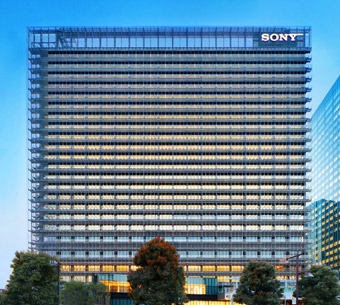BioSkin has received the 2014 Tall Building Innovation Award from the Council on Tall Buildings and Urban Habitat (CTBUH).
The NBF Osaki Building (formerly named Sony City Osaki) is the first structure to install BIOSKIN, a new exterior system based on the principles behind “Sudare’’, or traditional Japanese screens usually made by thin bamboo. Nikken Sekkei designed an environmental system utilizing such runoff rainwater that combines both the building-centered effect inspired by the custom of sprinkling water to allay heat to cool down the building itself, and the altruistic effect of alleviating the heat-island phenomenon for the surrounding environment as a whole. This is the idea behind the bioskin. Ultimately, the system is quite a primitive and simple: rain water circulated using electricity generated by solar power through unglazed terracotta pipes arranged along the façade vaporizes, cooling down the building itself as well as the surrounding area.
A tension structure was employed in order to keep materials used to a minimum and curtail CO2 emissions at construction time, but the slim-lined louvers [ceramic pipes] against the stalwart steel frame of the building gives it a distinctively fine-lined look. Simulations showed that the bioskin system could lower the temperature of the building by 10 degrees under clear skies using vaporized rainwater alone and 4 degrees under cloudy skies, and indicated that because of the sheer size of the 140- by 120-meter building, it could achieve an approximately 2-degree decrease in ground-surface temperature using zero energy. The area outside the building uses natural earth rather than artificial foundations as much as possible in order to further enhance the heat-vaporization effects. The area around the building, moreover, forms a green zone that is laid out for continuity with existing greenery both within and nearby the site.20,000㎡.
More importantly, the form minimizes the heat island effect by positioning its narrow sides against prevailing winds, thus allowing the breeze to flow in from Tokyo Bay without hindrance. The building was then conceived as a massive cooling devise that performs in much the same way as a natural forest.
The recipients of the award are as follows:
Kazuhiko Yamanashi, Tatsuya Hatori, Yoshito Ishihara, Norihisa Kawashima (former staff member)
Please click here to view the official announcement of The CTBUH 2014 Innovation Award Winners
A tension structure was employed in order to keep materials used to a minimum and curtail CO2 emissions at construction time, but the slim-lined louvers [ceramic pipes] against the stalwart steel frame of the building gives it a distinctively fine-lined look. Simulations showed that the bioskin system could lower the temperature of the building by 10 degrees under clear skies using vaporized rainwater alone and 4 degrees under cloudy skies, and indicated that because of the sheer size of the 140- by 120-meter building, it could achieve an approximately 2-degree decrease in ground-surface temperature using zero energy. The area outside the building uses natural earth rather than artificial foundations as much as possible in order to further enhance the heat-vaporization effects. The area around the building, moreover, forms a green zone that is laid out for continuity with existing greenery both within and nearby the site.20,000㎡.
More importantly, the form minimizes the heat island effect by positioning its narrow sides against prevailing winds, thus allowing the breeze to flow in from Tokyo Bay without hindrance. The building was then conceived as a massive cooling devise that performs in much the same way as a natural forest.
The recipients of the award are as follows:
Kazuhiko Yamanashi, Tatsuya Hatori, Yoshito Ishihara, Norihisa Kawashima (former staff member)
Please click here to view the official announcement of The CTBUH 2014 Innovation Award Winners

One of the world’s largest architectural design firms with over 2,500 professional staff, Nikken Sekkei and its six Group companies offer comprehensive design, engineering, management, consulting and R&D services. Established in 1900, the company’s portfolio consists of over 25,000 projects in 50 countries. Its activities cover a wide spectrum of sustainable public and private endeavors including: new city design, high-density/mixed- use transit-oriented developments, super-high rise buildings, business parks, offices and facilities for commercial, cultural, educational and healthcare use. Nikken is headquartered in Tokyo and maintains branch offices in China, Korea, Vietnam, Singapore, Russia, Spain and the UAE.